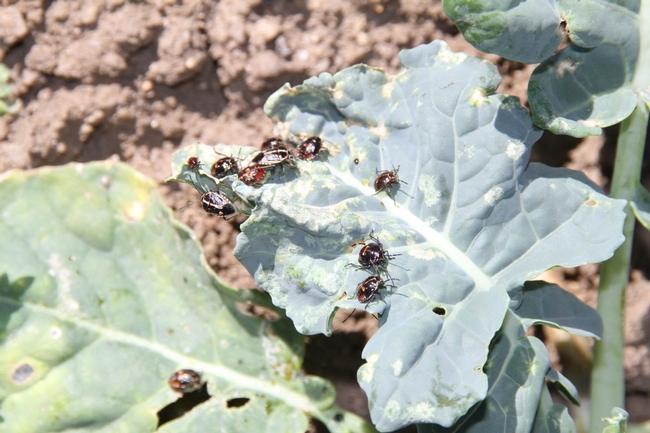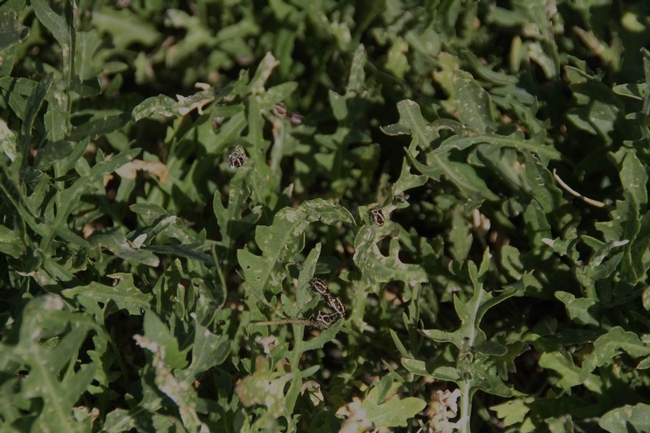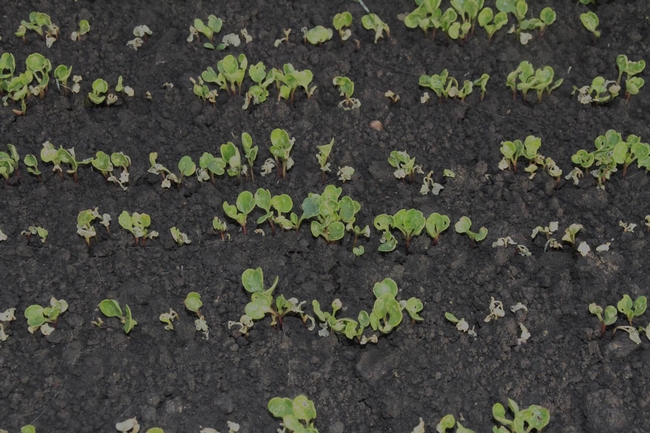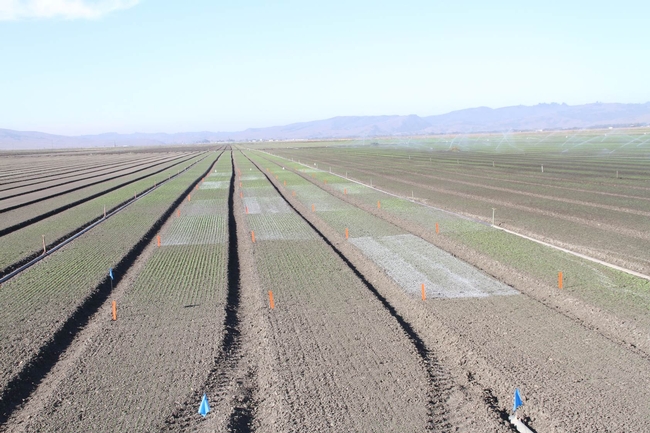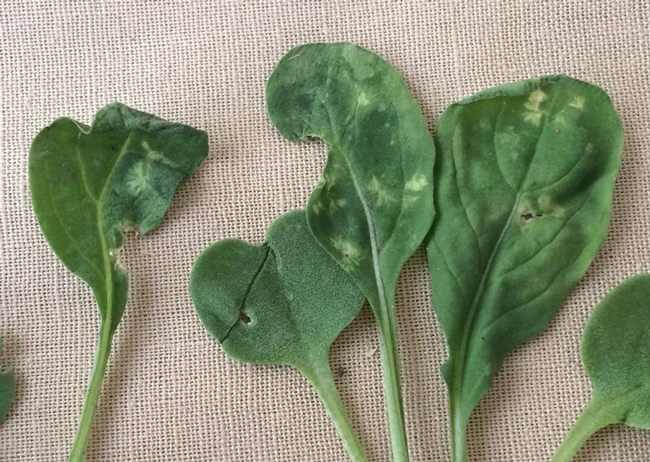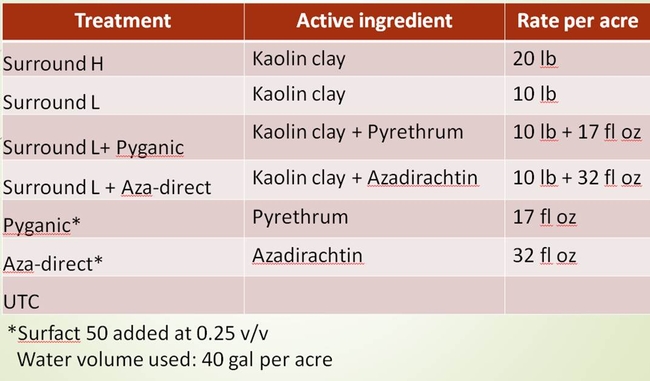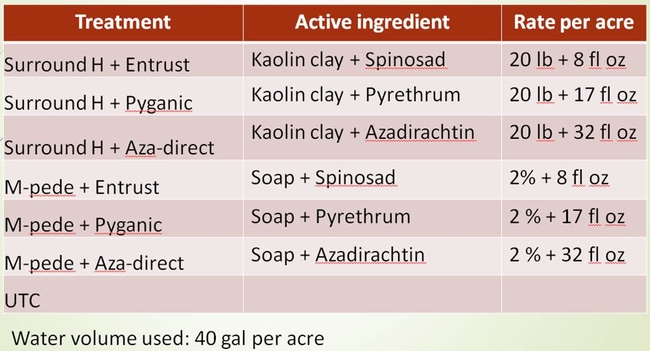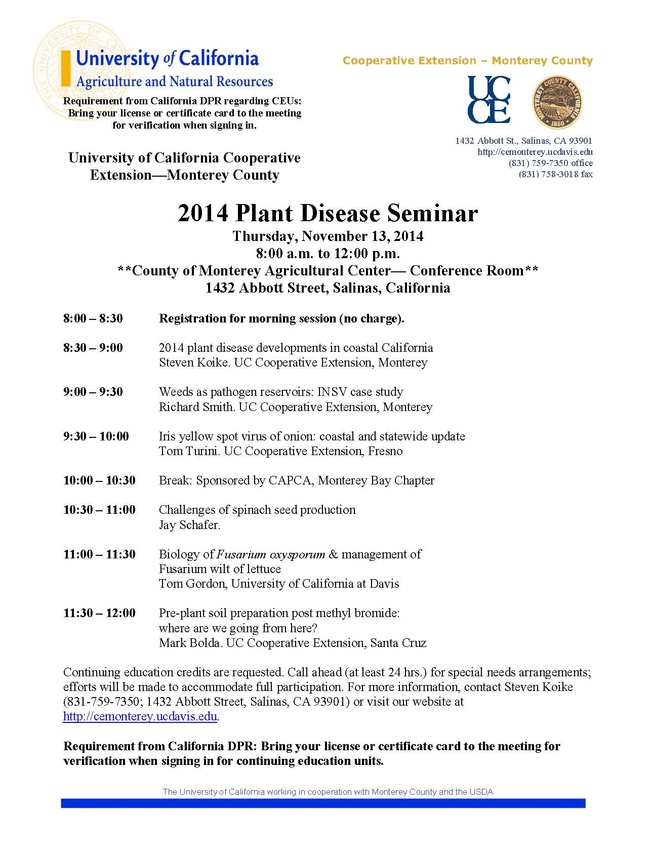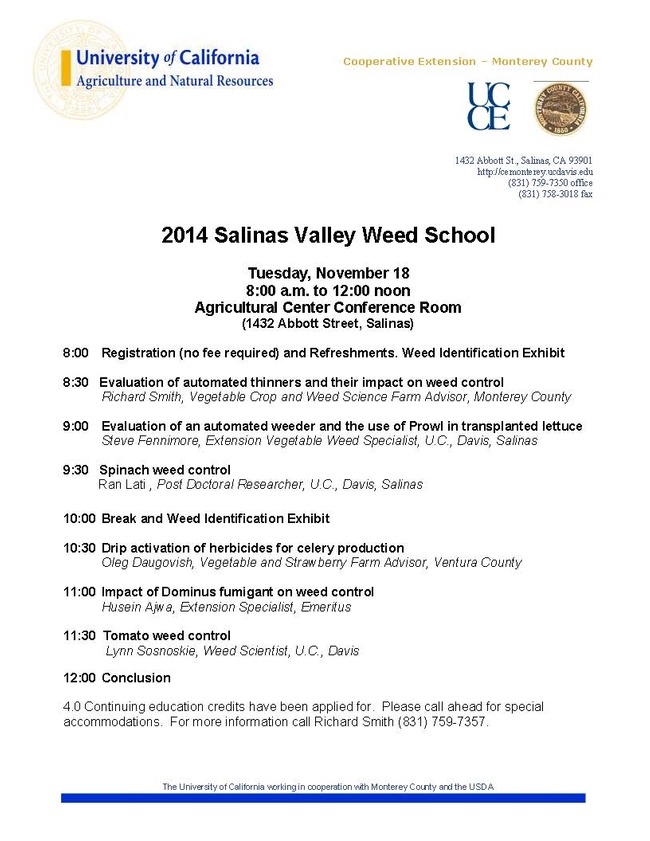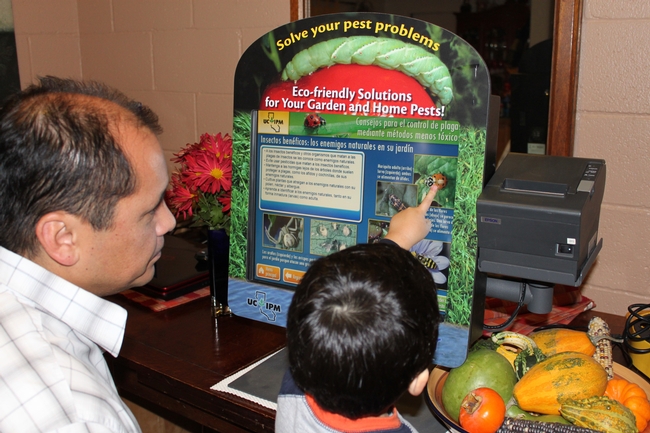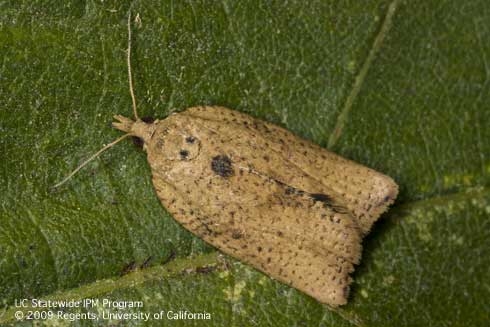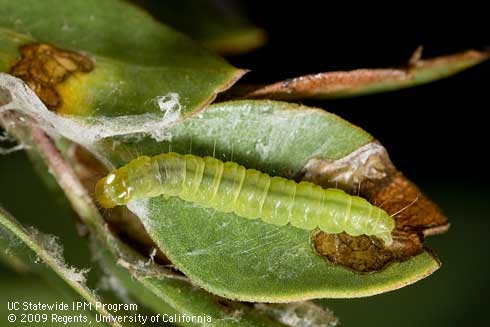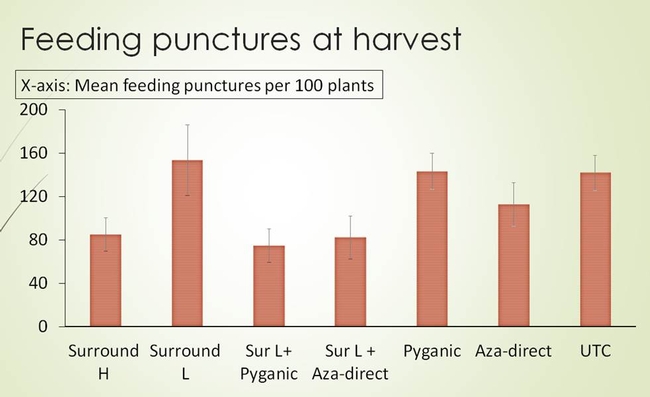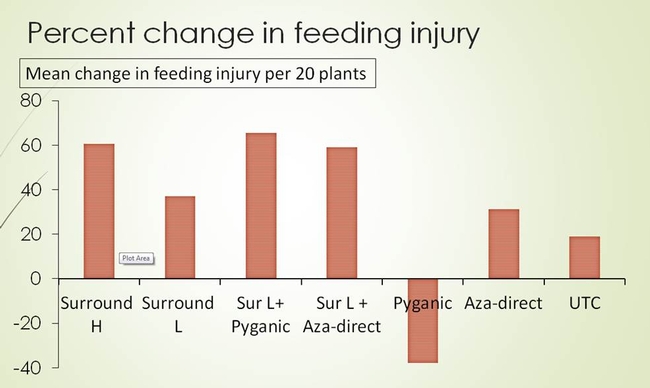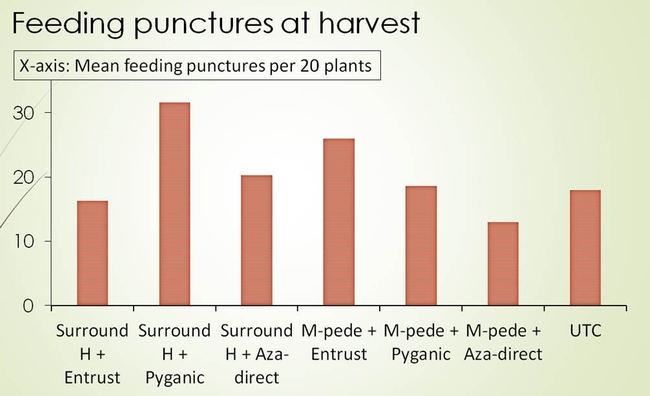- Author: Cheryl Reynolds
The UC Statewide IPM Program has many resources available to help Spanish-speaking audiences manage pests and apply pesticides safely.
For our Spanish-speaking urban audiences, several short videos on common pests such as ants, spiders, snails, bed bugs, and mosquitoes are available as well as Quick Tips (Notas Breves) offering advice on many pest problems and information on using pesticides safely. There are also 16 touch-screen computer kiosks located in various locations around the state where users can find pest and pesticide information in English or Spanish.
For maintenance gardeners preparing to take the California Department of Pesticide Regulation's Pesticide Applicators exam in the category Q, UC IPM offers a study guide and free online training course in Spanish.
For agriculture audiences, there are several pesticide safety-related books and DVDs available as well as guidelines for managing strawberry pests.
For more on other pest management and pesticide safety information available, please see the UC IPM Web site.
- Author: Ria Debiase
Nursery workers are our first line of defense in detecting light brown apple moth when growing ornamental plants in commercial nurseries. A new brochure and video can help those in the field distinguish light brown apple moth from several look-alike caterpillars.
Light brown apple moth is currently under a California Department of Food and Agriculture quarantine that regulates the interstate shipment of plants to keep the moth from spreading to new areas. It has been quarantined in various counties throughout coastal California ranging from Mendocino to San Diego.
Correct field identification of the light brown apple moth is the first step in containing the spread of this moth. Unfortunately several other leafroller caterpillars, including the orange tortrix, omnivorous leafroller, avocado leafroller, and apple pandemic moth, look similar to light brown apple moth caterpillars. This makes photo identification tools that can go into the field with workers, like the Field Identification Guide for Light Brown Apple Moth in California Nurseries, a useful resource for nursery workers.
The field guide was created by Steven Tjosvold, Neal Murray, University of California Cooperative Extension; Marc Epstein, Obediah Sage, California Department of Food and Agriculture; and Todd Gilligan, Colorado State University with the Statewide Integrated Pest Management Program (UC IPM).
An exotic and invasive pest from Australia, light brown apple moth has a host range of more than two thousand plants. It is a pest to a wide range of ornamental and agricultural crops, including caneberries, strawberries, citrus, stone fruit, apples, and grapes. The caterpillars eat leaves and buds, leading to weak or disfigured plants. They also can feed directly on fruit, causing the fruit to be unmarketable.
For more information on light brown apple moth and other leafrollers found in nurseries, see the UC Pest Management Guidelines for Floriculture and Nurseries.
- Author: Shimat Villanassery Joseph
Bagrada bug, Bagrada hilaris (Fig. 1) continues to be a major pest of brassica crops in the Salinas Valley and Hollister causing severe crop losses for both organic and conventional growers alike. Organic growers are struggling because there are very limited options at disposal to suppress the bagrada bug populations in the field. Conventional growers on the other hand are relying heavily on pyrethroid and neonicotinoid insecticides and are going with more number of applications than normal during early stages pf crop development (Cotyledon to four true leaves stage). This tactic (multiple applications) benefit the young seedlings as insecticide residues protect the plants from bagrada bug feeding especially, on the growing point or apical meristematic tissue. Feeding injury to meristematic tissue would cause “blind” head (no head) and multiple shoots on heading brassica crops such as broccoli, cauliflower or cabbage. With couple of insecticide applications at early stages of brassica crop, conventional growers are facing 5-30% loss from bagrada bug feeding injury. Some growers finding noticeably high mortality of cotyledons forcing them to skip thinning operation to maintain a decent crop stand.
Bagrada bug is taking a huge toll on leafy brassica crops such as Chinese cabbage (Pak Choi or Bak Choi), Arugula, Mizuna, Totsoi and Kale. These crops become unmarketable from direct feeding injury on the leaves (Fig. 2). These crops are like “magnets” for bagrada bugs. Bagrada bugs can precisely detect the seeds planted in the soil and most of the seedlings emerge with bagrada bug feeding injury. Sometimes, severe feeding at young stages cause plants die upon emergence (Fig. 3).
Two field trials were conducted in Hollister seeking organic insecticide options for bagrada bug management. The insecticide products chosen were Surround (Kaolin clay), Pyganic, Aza-direct, Entrust and M-pede. Surfact 50 was added when the Pyganic and Aza-direct were used alone. These organically approved insecticides were combined with other insecticides based on certain assumptions. For example, when insecticide Surround is sprayed, it forms a thin particle film on the leaf surface without affecting light transmission or photosynthesis. As bagrada bugs crawl on the Surround treated surface, the particles could stick to their body possibly cause irritation and force them to crawl off from the treated surface. This phenomenon if occurs, it could reduce the incidence of bagrada bug feeding injury. Moreover, it is possible that combining insecticides such as Pyganic and Aza-direct with Surround may increase insecticide exposure as bagrada bugs groom to remove the clay particles stuck on their body using their legs or wings.
The field where the trials were conducted had enormous bagrada bug pressure. Bagrada bugs were everywhere that one would easily kill “thousands of bugs” just by walking over the beds. All stages of bagrada bug were present in the field at the time of insecticide applications. The applications were targeted to protect the plants from feeding injury and not particularly to kill the bugs. The first trial was conducted in Mizuna field and the second trial was conducted in Arugula field. In both the trials, the products were applied four times at three-day interval until harvest between 7 AM and 9 AM. The water volume used was 40 gal per acre. The products were applied using the pneumatic sprayer or back pack sprayer. The details of the products, active ingredients and the rates used for the trials are shown in the Tables 1 and 2. The design of experiments was Completely Randomized Block Design with four replications (Fig. 4). Plant samples were collected twice a week and were evaluated for bagrada bug feeding injury on the true leaves (Fig. 5).
In trial 1, the bagrada bug feeding injury was numerically lower on Mizuna plants that received higher rate of Surround (alone) and Surround combined with Pyganic or Aza-direct than on untreated plants (Fig. 6). When the percentage change in bagrada bug injury on true leaves was calculated (taller the histogram, better the product performance), the plants treated with higher rate of Surround, and Surround combined with Pyganic or Aza-direct had greater reduction of bagrada bug feeding than untreated plants (Fig. 7). In trial 2, none of the treatments showed any indication of suppression when compared with untreated plants (Fig. 8).
Basically, these studies did not provide definite answers to the questions posed or problem but provided some trends. It appears that combining Pyganic or Aza-direct with Surround may have some value rather than applying alone. The Surround rate 20 lb per 40 gal of water is maximum rate for this product. Because Surround could clog the spray tanks, it requires rigorous agitation before application. Also, because Surround easily comes off from the leaf surface with sprinkler irrigation, reapplications are warranted if irrigated at closer intervals especially during the early stages of the crop. The rate of M-pede used in the study was 2% of the water volume. Typically, 2% of M-pede is considered as a high rate and increasing the rate (> 2%) may cause phytotoxicity (burning of leaves).
Then, can we manage bagrada bug?
Few thoughts:
- Perhaps, we should approach this problem differently. Bagrada bug is a landscape scale pest that they could reproduce and build-up to huge populations if the food is available in plenty, and warm and dry conditions persist. So far, we learned that their population build-up starting late July to December in the Salinas Valley and Hollister. The warmer conditions favor rapid reproduction and several overlapping generations of bagrada bug would develop in short period.
- We observed that their population pressure vary across landscapes and is a serious problem where the control options are limited. For example, bagrada bug problem is less severe when the management is aggressive such as conventional fields where growers have effective products that could suppress or knock down their populations at least in the crops grown. Organic growers on the other hand have limited options to fight bagrada bug and its population rapidly grows into uncontrollable size.
- We also noticed that initially these bugs invade the plants in the edge of the field from the surrounding fields or risk zones (e.g. ditches).
- These facts suggest that this is a landscape level problem rather than a field level problem. Bagrada bug management approach probably should include the management of various kinds of hosts that function as reservoir (e.g. brassica weeds) and aid to sustain their populations (brassica crops).
- Cultural management: Avoid planting brassica crops back-to-back pattern or staggered pattern. This would provide opportunity for bagrada bug to utilize the continuous supply of food to reach uncontrollable population size in short period of time. If somehow, the growers could disrupt the ecology of bagrada bug by not growing brassica crops in succession for a period instead rotate with non-brassica hosts, their population might crash and reach to a controllable levels.
- Weed management: Aggressive weed management especially brassicaceous weeds along with tight cultural management would disrupt the food supply and prevent escalation of population size.
- Bagrada bugs have demonstrated the ability to survive on non-brassica hosts especially solanaceous crops such as tomato, potato or pepper but would rarely reach to the levels we are seeing in brassica fields.
For further reading on bagrada bug please click on the following links (UC IPM pest note or blog articles).
http://www.ipm.ucdavis.edu/pestalert/pabagradabug.html
http://ucanr.edu/blogs/blogcore/postdetail.cfm?postnum=14915
http://ucanr.edu/blogs/blogcore/postdetail.cfm?postnum=11632
http://ucanr.edu/blogs/blogcore/postdetail.cfm?postnum=11591
Please contact me (Shimat Joseph) by email at svjoseph@ucanr.edu or phone at 831-229-8985 if you have any questions or comments.
